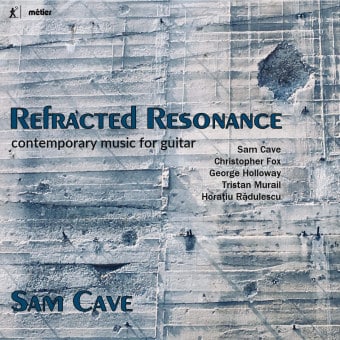Gitarr och Luta
Often, the guitar is a really cosy instrument, dedicated to creating a charming, romantic atmosphere and the literature is full of nice ear candy that easily goes with the furniture. English guitarist Sam Cave certainly has another focus and has positioned himself as a musician looking for the sonic universes that are to be explored beyond the common repertoire and the traditional ways of playing. This is an approach that places trust in the listener’s ability to take the time to enter with curiosity into unknown worlds, and at the same time demanding a lot from the musician, the instrument and (in this case) the capacity of a recording to capture the width of the sound as naturally as possible.
”Music” is sometimes a very narrow expression and maybe ”sound art” would fit this program better, as the individual sounds and their sonic character often are at the center of attention and where the very nature of sound is handled in a way reminiscent of how it has been explored previously, in the fields of electronic and electro-acoustic music. What is a sound and how can it be created and treated? And where is the line between sound as a concrete acoustic phenomenon and moods, emotional sensations and notions? Is there always a line? What we hear on this CD might, in lack of better terms, be described as avant-garde, but another way of putting it might be ‘meditative’, or ‘open-minded’ listening.
Here is the fascination of resonance, the individual sounds or notes and their multi-faceted essence at the center of attention. Some of the six works presented here use microtones, which may at first feel strange and just ”out-of-tune”, but it contributes to widening the capacity of the guitar, turning it into a very rich instrument with so much power of expression. Likewise, overtones play a central role –- they are often created through harmonics, but in the piece ”Subconscious Wave” (where the guitar in accompanied by electronic sounds) by Horatiu Radeluscu, the performer is using a bow on a steel-string guitar, thereby creating so many more sounds that I thought was possible to achieve on a guitar.
The opening piece ”Tellur” by Tristan Murail uses different methods for plucking the strings in a sort of non-moving space of sound. This gives rise to contrasting movements within a restricted area. Two sonatas by George Holloway are presented; in the first the music moves between two distinct poles, one created by harmonics, the other by ordinary plucking. The second sonata is a bit more severe or laconic, and carries a barren beauty, like a windswept landscape. ”Chile” by Christopher Fox is clearly program music (it was written in 1991, which makes its theme more apparent), and illustrates the contrast between democracy and the repression of the military junta in Chile. The rhythmic way of playing is ”typical latin- american”.
Everything comes to a closure with a short composition by Sam Cave himself, ”Refracted Meditations III”, a thoughtful and beautifully fragile summoning up of the program.
Sam Cave plays with excellent concentration and a sense of honesty and respect regarding the material. He urges you to listen with open senses and reveals a rich world of musical being, far from the main roads of mainstream culture. He has dug deeply into his own art of expression, with a sense of humble authority thereby affirming the guitar’s position as an instrument capable of reaching beyond its romantic associations and becoming a medium for great, groundbreaking art. This CD, recorded in a church in London, is great sounding and has the power to naturally deliver the abstract beauty of this music.
@divineartrecordingsgroup
A First Inversion Company
Registered Office:
176-178 Pontefract Road, Cudworth, Barnsley S72 8BE
+44 1226 596703
Fort Worth, TX 76110
+1.682.233.4978












